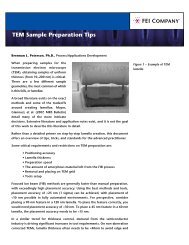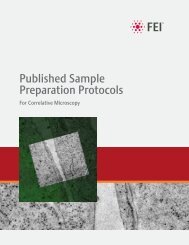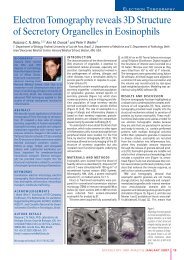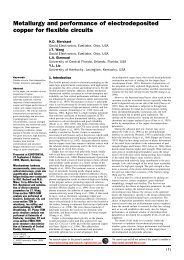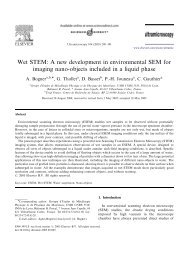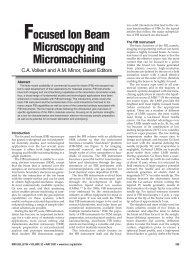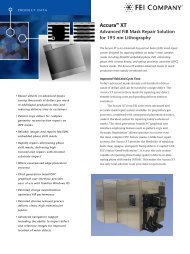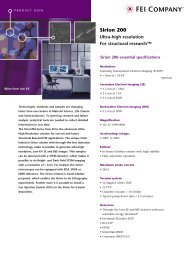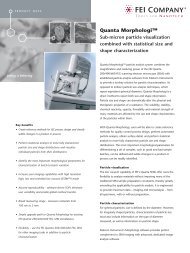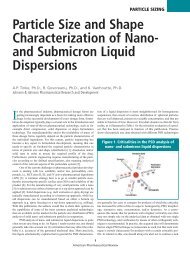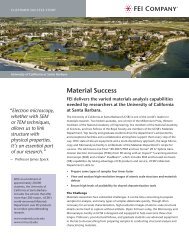Ballistic Substage for Quanta™ Series SEM - FEI Company
Ballistic Substage for Quanta™ Series SEM - FEI Company
Ballistic Substage for Quanta™ Series SEM - FEI Company
Create successful ePaper yourself
Turn your PDF publications into a flip-book with our unique Google optimized e-Paper software.
PRODUCT DATA<br />
Any sample, all data<br />
Simultaneous rotation of two objects<br />
Rotation via <strong>SEM</strong> motor stage<br />
Holder <strong>for</strong> cartridge cases and separate<br />
holder <strong>for</strong> bullets<br />
Easy mounting and handling<br />
Fits 5-axis motorised stages<br />
of Quanta 400 and 600<br />
<strong>Ballistic</strong> <strong>Substage</strong> <strong>for</strong><br />
Quanta series <strong>SEM</strong><br />
Firearms identification<br />
Forensic firearms examinations are based on firearms<br />
identification. This involves the identification of a<br />
bullet, cartridge case, or ammunition components<br />
(GSR particles). Singular identification of bullets or<br />
cartridges can be attributed to specific machining<br />
processes of firearms.<br />
Identifying features of fired ammunition (1)<br />
When a gun is discharged, the grooves in the barrel<br />
cause the bullet to spin as it travels the length of the<br />
barrel and thus stabilise the bullet during flight. At<br />
the same time, the expansion of the fired cartridge and<br />
the high pressures propelling the bullet through the<br />
bore of the barrel press and scrape the bullet against the<br />
rifling as it heads toward the muzzle. As a result the<br />
fired bullet will bear the negative impressions of the<br />
grooves in a rifled barrel; these marks are described by<br />
firearms examiners as land and groove impressions, or<br />
lands and grooves.<br />
In addition to the rifling marks produced on a bullet<br />
by its passage through a gun barrel, a number of other<br />
impressions found on cartridge cases and resulting from<br />
machining processes are crucial to firearms<br />
identification. Firing pin impressions, breechface marks,<br />
extractor marks, ejector marks and chamber marks,<br />
when present and of sufficient quality, are all features<br />
used by firearms examiners in their analyses. During<br />
the discharge of a firearm, the firing pin strikes the<br />
primer of a cartridge, creating microscopic contact marks<br />
and unique indentations. As the powder within the<br />
cartridge begins burning, the cartridge case is propelled<br />
backwards against the breechface with enough <strong>for</strong>ce to<br />
be impressed with the characteristic microscopic features<br />
of that surface.
PRODUCT DATA<br />
Extractor and ejector marks are<br />
produced when the cartridge case is<br />
mechanically extracted from the<br />
chamber and ejected and are visible as<br />
fine striations and gouged impressions<br />
on the rim and head of the case.<br />
Chamber marks, parallel striations on<br />
the cartridge case caused by contact<br />
with the walls of the chamber of the<br />
firearm, also occur at this time. All of<br />
these potentially identifying features<br />
are produced as a result of the<br />
machining and finishing processes<br />
of firearms manufacture, which<br />
inevitably leave microscopically rough<br />
areas and edges on the parts of a given<br />
gun. During discharge, these<br />
imperfections are transferred from the<br />
metal parts of the firearm to the bullet<br />
and cartridge case.<br />
Examination<br />
Traditionally, examination is done<br />
using an optical microscope. Due to<br />
lack of depth of focus optical<br />
microscopes do not have the ability<br />
to reveal fine detail seen at higher<br />
magnification. The <strong>SEM</strong> has a far<br />
superior depth of field. It can produce<br />
images covering a wide range of<br />
magnifications and depths on many<br />
types of surfaces, including rough<br />
and curved surfaces. Microanalysis is<br />
also possible.<br />
SK.1.R <strong>for</strong> cartridge cases SK.SB <strong>for</strong> bullets<br />
<strong>Ballistic</strong> substage <strong>for</strong> <strong>FEI</strong><br />
Forensic <strong>SEM</strong><br />
A new ballistic substage is available<br />
<strong>for</strong> <strong>FEI</strong>’s Quanta 400 and 600. This<br />
substage (or “module”) is used <strong>for</strong><br />
rapid investigation of the surface, to<br />
search <strong>for</strong> marks generated when the<br />
bullet or slug passes through a gun<br />
or pistol barrel. The specimen is<br />
clamped between spring loaded<br />
points. The module can hold two<br />
bullets and/or cartridge cases <strong>for</strong> slow<br />
rotation along their axis using the<br />
motor stage of the <strong>SEM</strong>. Parallel<br />
markings are at right angles to the<br />
direction of the electron detector. In<br />
this way, optimum contrast is<br />
generated in secondary or backscatter<br />
electrons, providing a tool <strong>for</strong> the<br />
recording of characteristic patterns,<br />
showing results which can correlate to<br />
or exclude a given weapon.<br />
Both objects will rotate together at<br />
the same time. The <strong>SEM</strong> stage<br />
software will store all stage positions,<br />
including rotation, so comparison of<br />
two objects is easy. The second object<br />
is rotated and imaged live whilst<br />
comparing to a frozen image of a<br />
typical mark on the first object.<br />
The rotation holder also fits<br />
XL <strong>SEM</strong>s, equipped with a 5-axis<br />
motorised 100x100 mm stage or<br />
150x150 mm stage.<br />
<strong>FEI</strong> <strong>Company</strong><br />
World Headquarters and<br />
North American Sales<br />
7451 NW Evergreen Parkway<br />
Hillsboro, OR 97124-5830<br />
Tel: +1 503 640 7500<br />
Fax: +1 503 844 2615<br />
e-mail: sales@feico.com<br />
www.feicompany.com<br />
Firing pin impression<br />
Ejector mark<br />
The ballistic substage may also be<br />
used <strong>for</strong> other applications where<br />
sample rotation along a horizontal<br />
rotation axis is required. The rotation<br />
holder consists of a module <strong>for</strong><br />
cartridge cases (SK.1.R), which is<br />
driven by the telescope shaft of the<br />
<strong>SEM</strong> and a module <strong>for</strong> bullets (SK.SB).<br />
This kit can hold bullets of different<br />
length.<br />
(1) Firearms and Toolmarks in the FBI<br />
Laboratory, Part 1, Sally A. Schehl, FBI,<br />
Washington, DC<br />
European Sales<br />
Tel: +31 40 27 66 768<br />
Fax: +31 40 27 66 786<br />
Asia-Pacific Sales<br />
Tel: +65 351 7671<br />
Fax: +65 354 0644<br />
©2002. We are constantly improving the per<strong>for</strong>mance of our products, so all<br />
specifications are subject to change without notice. The <strong>FEI</strong> logo, The Structural<br />
Process Management <strong>Company</strong> and E<strong>SEM</strong> are trademarks of <strong>FEI</strong> <strong>Company</strong>.<br />
Windows is a trademark of Microsoft Corporation.<br />
032-DS00111 03/01<br />
2



